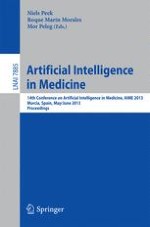2013 | Book
Artificial Intelligence in Medicine
14th Conference on Artificial Intelligence in Medicine, AIME 2013, Murcia, Spain, May 29 – June 1, 2013. Proceedings
Editors: Niels Peek, Roque Marín Morales, Mor Peleg
Publisher: Springer Berlin Heidelberg
Book Series : Lecture Notes in Computer Science
